多恩布什《宏观经济学》第10版课后习题详解(收入与支出)【圣才出品】
多恩布什《宏观经济学》第10版 第9章 收入与支出

AD C I G NX
在均衡的产出水平上,总供给等于总需求 (Output is at its equilibrium level when
the quantity of output produced is equal to
the quantity demanded.)。因此,当下式成立时, 经济处于均衡产出水平(equilibrium level of output)。
因此有:
AD C I G NX C c Y TA TR I G NX C c TA TR I G NX cY A cY 上述方程的总需求函数如图9-2所示。可以看出,
总需求也决定于收入水平,随着收入水平的增加而 增加。
demand and therefore output.)
●增加自发支出所增加的产出,大于1:1,换 言之,存在着一种乘数效应。(Increases in autonomous spending increase output more than one for one. In other words, there is a multiplier effect.) ●乘数的大小取决于边际消费倾向与税率。 (The size of the multiplier depends on the
5.储蓄与投资 总需求等于产出的均衡条件,在均衡状态下,
可以表示为计划投资等于储蓄(In equilibrium,
planned investment equals saving)。这个条件 只适用于没有政府部门和没有对外贸易的经济中。
图9-3
储蓄与投资
均衡收入水平是在 AD 与45°线的交点 E 点出 现的。所以,在均衡收入水平上,并且只有在这一 水平上,储蓄等于(计划)投资。相形之下,收入 高于均衡收入水平Y0时,储蓄(45°线与消费曲线 之间的距离)超过计划投资。收入低于 Y0时,则计 划投资超过储蓄。
(NEW)多恩布什《宏观经济学》(第10版)笔记和课后习题详解

答:总供给—总需求模型是把总需求与总供给结合在一起来分析国民收 入与价格水平的决定及其变动的国民收入决定模型。
在图1-4中,横轴代表国民收入( ),纵轴代表价格水平( ), 代 表原来的总需求曲线, 代表短期总供给曲线, 代表长期总供给曲 线。最初,经济在 点时实现了均衡,均衡的国民收入为 ,均衡的价 格水平为 。这时 点又在长期总供给曲线 上,所以, 代表充分就 业的国民收入水平。在短期内,政府通过扩张性的财政政策或货币政 策,增加了总需求,从而使总需求曲线从 向右上方平行地移动到了
(1)经济增长模型
主要解释:经济增长的源泉;各国经济增长率差异的原因;经济起飞的 原因;分析投入的积累和技术进步如何导致生活水平的提高。
(2)经济波动模型:总供给—总需求模型(如图1-1所示)
图1-1 总供给—总需求模型
总供给—总需求模型解释物价水平与产出的决定与波动。
总供给水平:现有资源和技术条件下,经济能够生产的产出量。
潜在产出水平附近接近于一条垂直的直线。
4 经济周期(business cycle)
答:经济周期又称经济波动或国民收入波动,指总体经济活动的扩张和 收缩交替反复出现的过程。现代经济学中关于经济周期的论述一般是指 经济增长率的上升和下降的交替过程,而不是经济总量的增加和减少。
一个完整的经济周期包括繁荣、衰退、萧条、复苏(也可以称为扩张、 持平、收缩、复苏)四个阶段。在繁荣阶段,经济活动全面扩张,不断 达到新的高峰。在衰退阶段,经济短时间内保持均衡后出现紧缩的趋 势。在萧条阶段,经济出现急剧的收缩和下降,很快从活动量的最高点 下降到最低点。在复苏阶段,经济从最低点恢复并逐渐上升到先前的活 动量高度,进入繁荣。衡量经济周期处于什么阶段,主要依据国民生产 总值、工业生产指数、就业和收入、价格指数、利息率等综合经济活动 指标的波动。
多恩布什《宏观经济学》第10版课后习题详解(货币、利息与收入)【圣才出品】

5. IS 曲线( IS curve)
答: IS 曲线指将满足产品市场均衡条件的收入和利率的各种组合的点连结起来而形成
的曲线。它是反映产品市场均衡状态的一幅简单图像。它表示的是任一给定的利率水平上都
M P h h kbG
h 与 k 数值越小,b 与 G 数值越大,增加实际余额对均衡收入水平的扩张性效应也越大。 b 与 G 的数值大,对应着非常平直的 IS 曲线。
4.中央银行(central bank) 答:中央银行指在一国金融体系中居于主导地位,负责制定和执行国家的金融政策,调 节货币流通与信用活动,对国家负责,在对外金融活动中代表国家,并对国内整个金融体系 和金融活动实行管理与监督的金融中心机构。中央银行具有三大职能,即它是“发行的银行”、 “银行的银行”和“政府的银行”。
2 / 21
圣才电子书 十万种考研考证电子书、题库视频学习平台
(1)中央银行是发行的银行,这一职能指中央银行服务于社会和经济发展,供应货币、 调节货币量、管理货币流通的职能。
(2)中央银行是银行的银行,这一职能指中央银行服务于商业银行和整个金融机构体 系,履行维持金融稳定、促进金融业发展的职责。
6.货币市场的均衡曲线(money market equilibrium schedule)
3 / 21
圣才电子书 十万种考研考证电子书、题库视频学习平台
答:LM 曲线即货币市场的均衡曲线,它显示能使其实际余额需求等于供给的所有利率
与收入水平的组合。沿着 LM 曲线,货币市场处于均衡状态。要使货币市场处于均衡状态,
A bi
多恩布什《宏观经济学》第10版课后习题详解(国际调整与相互依存)【圣才出品】
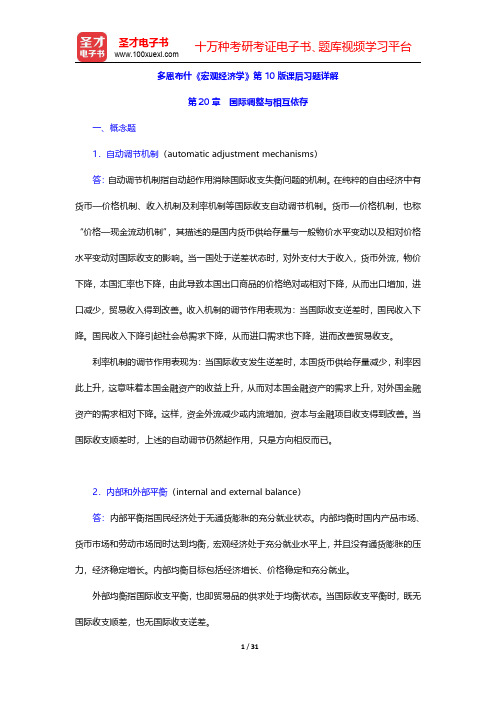
多恩布什《宏观经济学》第10版课后习题详解第20章国际调整与相互依存一、概念题1.自动调节机制(automatic adjustment mechanisms)答:自动调节机制指自动起作用消除国际收支失衡问题的机制。
在纯粹的自由经济中有货币—价格机制、收入机制及利率机制等国际收支自动调节机制。
货币—价格机制,也称“价格—现金流动机制”,其描述的是国内货币供给存量与一般物价水平变动以及相对价格水平变动对国际收支的影响。
当一国处于逆差状态时,对外支付大于收入,货币外流,物价下降,本国汇率也下降,由此导致本国出口商品的价格绝对或相对下降,从而出口增加,进口减少,贸易收入得到改善。
收入机制的调节作用表现为:当国际收支逆差时,国民收入下降。
国民收入下降引起社会总需求下降,从而进口需求也下降,进而改善贸易收支。
利率机制的调节作用表现为:当国际收支发生逆差时,本国货币供给存量减少,利率因此上升,这意味着本国金融资产的收益上升,从而对本国金融资产的需求上升,对外国金融资产的需求相对下降。
这样,资金外流减少或内流增加,资本与金融项目收支得到改善。
当国际收支顺差时,上述的自动调节仍然起作用,只是方向相反而已。
2.内部和外部平衡(internal and external balance)答:内部平衡指国民经济处于无通货膨胀的充分就业状态。
内部均衡时国内产品市场、货币市场和劳动市场同时达到均衡,宏观经济处于充分就业水平上,并且没有通货膨胀的压力,经济稳定增长。
内部均衡目标包括经济增长、价格稳定和充分就业。
外部均衡指国际收支平衡,也即贸易品的供求处于均衡状态。
当国际收支平衡时,既无国际收支顺差,也无国际收支逆差。
在开放经济中,宏观经济的最终目标是实现内部均衡和外部均衡。
英国经济学家詹姆斯·米德开创性地提出了“两种目标、两种工具”的理论模式,即在开放经济条件下,一国经济如果希望同时达到对内均衡和对外均衡的目标,则必须同时运用支出增减政策和支出转换政策两种工具。
多恩布什《宏观经济学》(第10版)笔记和课后习题详解 第9章 收入与支出【圣才出品】

第3篇首要的几个模型第9章收入与支出9.1复习笔记一、总需求与均衡产出1.总需求概述(1)总需求的含义与构成总需求指整个经济社会在每一个价格水平下对产品和劳务的需求总量,它由消费需求、投资需求、政府支出和国外需求构成。
将商品需求区分为消费(C)、投资(I)、政府采购(G)、与净出口(NX)等需求,则总需求(AD)由下面的公式决定:=+++AD C I G NX(2)总需求与国民收入核算中总支出的区别①总需求指计划(意愿)支出量;国民收入中的总支出是指实际发生量;②一般而言在消费、政府采购、以及净出口方面两者不存在差异;③关键在于计划投资与实际投资之间的差别,在实际发生的投资中往往会出现非计划的存货投资。
2.均衡产出(1)均衡产出水平的含义均衡产出水平指总供给和总需求相一致时的产出水平。
经济社会的产量或者国民收入决定于总需求,均衡产出是和总需求相一致的产出,也就是经济社会的收入正好等于全体居民和企业想要有的产出。
当下式成立时,经济处于均衡产出水平状态:==+++Y AD C I G NX(2)非计划库存投资与产量调节机制当总需求即人们想要购买的量与产出不相等时,则存在非计划库存投资或负投资。
可将其概括为:IU Y AD=-,其中IU为非计划的库存投资。
图9-1产出调节机制①如果产出大于总需求,就有非计划库存投资0IU>,此时存在超额库存积累,企业会减少生产,直到产出与总需求再度均衡为止。
②如果产出低于总需求,0IU<,企业将增加生产直至均衡恢复为止。
③在均衡状态下,非计划存货投资为零,0IU=,企业没有增加或减少产出的激励。
以上论述的以存货调整为基础的产量调节机制如图9-1所示。
图9-1产出调节机制3.基本结论(1)总需求决定均衡产出(收入)水平(2)在均衡时,非计划库存投资等于零,而且消费者、政府以及外国居民都买到了他们想要购买的商品。
(3)以非计划库存变化为基础的产量调整将使经济达到均衡水平。
多恩布什《宏观经济学》(第10版)笔记和课后习题详解 第11章 货币政策与财政政策【圣才出品】
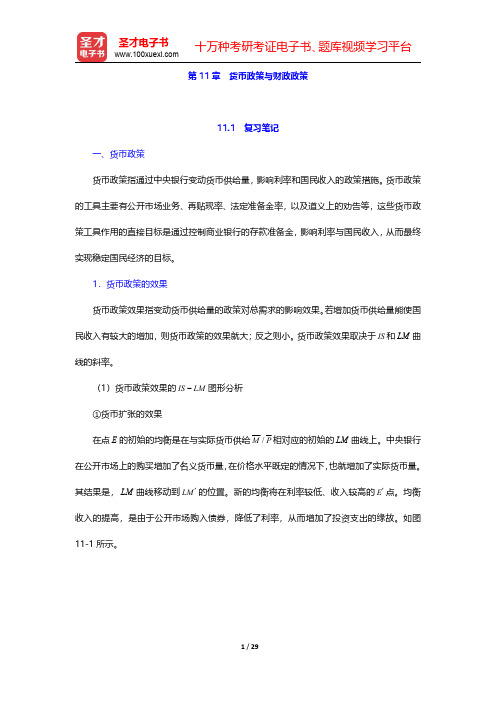
第11章货币政策与财政政策11.1复习笔记一、货币政策货币政策指通过中央银行变动货币供给量,影响利率和国民收入的政策措施。
货币政策的工具主要有公开市场业务、再贴现率、法定准备金率,以及道义上的劝告等,这些货币政策工具作用的直接目标是通过控制商业银行的存款准备金,影响利率与国民收入,从而最终实现稳定国民经济的目标。
1.货币政策的效果货币政策效果指变动货币供给量的政策对总需求的影响效果。
若增加货币供给量能使国民收入有较大的增加,则货币政策的效果就大;反之则小。
货币政策效果取决于IS和LM曲线的斜率。
(1)货币政策效果的IS LM-图形分析①货币扩张的效果在点E的初始的均衡是在与实际货币供给/M P相对应的初始的LM曲线上。
中央银行在公开市场上的购买增加了名义货币量,在价格水平既定的情况下,也就增加了实际货币量。
其结果是,LM曲线移动到LM'的位置。
新的均衡将在利率较低、收入较高的E'点。
均衡收入的提高,是由于公开市场购入债券,降低了利率,从而增加了投资支出的缘故。
如图11-1所示。
图11-1货币扩张政策②货币扩张的调整过程在初始均衡点E ,货币供给的增加造成了过量的货币供给。
对此,公众设法通过购买其他资产进行调整。
在此过程中,资产价格上涨,收益下降。
由于货币市场与资产市场的调整十分迅速,经济立即移动到1E 点。
在1E 点,货币市场出清,而公众愿意持有较多的实际货币量,因为利率有了充分的下降。
但在1E 点则有过量的商品需求。
利率下降,在初始收入水平0Y 既定的情况下,会提高总需求并且引起存货缩减。
对此的反应是,产出扩大,经济开始沿LM 曲线上升。
(2)货币政策效果的结论①LM 曲线越陡峭,收入变化就越大,货币政策效果越大。
a.如果货币需求对利率非常敏感(相当于相对平直的LM 曲线),只要利率有很小的变动,给定的货币存量的变动就可为资产市场所吸收。
因此,公开市场购买对于投资支出的作用很小,货币政策效果小。
多恩布什《宏观经济学》章节习题精编详解(收入与支出)【圣才出品】

第10章 收入与支出一、判断题 1.如果其他因素不变而边际消费倾向减小,国民收入将会增加。
( )【答案】F【解析】假设一个简单的两部门模型Y C I C cY I =+=++,得1Y C I c =+-,这里c 为边际消费倾向,当c 减小时,国民收入减少。
2.政府支出的变化直接影响总需求,但税收和转移支付则是通过它们对私人消费和投资的影响间接影响总需求。
( )【答案】T【解析】从三部门国民收入决定模型()Y C I G C c Y TA TR I G =++=+-+++可以看出,政府支出G 直接作用于国民收入,而税收和转移支付首先影响个人的可支配收入YD Y TA TR =-+,然后影响消费和投资决策,对国民收入产生间接影响。
3.在任何情况下,个人储蓄的增加都导致国民生产总值的减少。
( )【答案】F【解析】一方面,增加储蓄意味着相对来说消费者的消费支出减少,消费支出的减少会导致国民收入减少;另一方面,储蓄增加又会使得投资增加,进而使得国民收入增加。
所以很难说储蓄增加一定会使国民收入增加或是减少。
4.边际进口倾向越低,自发性投资变化对均衡产出的影响就越小。
( )【答案】F【解析】四部门模型中的投资乘数表达式为()111I c t αγ=--+。
γ的大小与投资乘数的大小呈反比,因此,边际进口倾向γ减小会使投资乘数增大。
5.考虑一个封闭经济,边际消费倾向为0.8,所得税税率为50%,假设投资I 为外生变量。
如果政府支出G 增加100,那么产出Y 的变化为50。
( )【答案】F【解析】封闭经济中政府购买乘数()15113G c t α==--,1005/3500/3G Y G α∆=⨯∆=⨯=。
6.在开放型经济中对外贸易乘数值大于三部门经济中的乘数值。
( )【答案】F【解析】在四部门经济中,由于引入外贸因素,在由外贸进出口因素的变化而引起的扩大的需求中,有一部分需求会因为购买进口商品而漏出,因此,开放经济中的外贸乘数小于三部门经济中的乘数值。
多恩布什《宏观经济学》课后习题详解(前沿课题)【圣才出品】

第24章前沿课题一、概念题1.GDP的周期成分(cyclical component of GDP)答:GDP的周期性成分指产出围绕其增长趋势的波动,即经济波动或经济周期。
经济增长的过程就是总体经济活动的扩张和收缩交替反复出现的过程。
一个完整的经济周期包括繁荣、衰退、萧条、复苏(也可以称为扩张、持平、收缩、复苏)四个阶段。
在繁荣阶段,经济活动全面扩张,不断达到新的高峰。
在衰退阶段,经济短时间保持均衡后出现紧缩的趋势。
在萧条阶段,经济出现急剧的收缩和下降,很快从活动量的最高点下降到最低点。
在复苏阶段,经济从最低点恢复并逐渐上升到先前的活动量高度,进入繁荣。
2.菜单成本(menu cost)答:菜单成本指企业为改变销售商品的价格,需要给销售人员和客户提供新的价目表所花费的成本,类似于饭馆改变价格重新制作菜单所产生的成本。
它是新凯恩斯主义为反击新古典主义的批判并证明其所主张的价格黏性的重要理由。
关于菜单成本能否引起价格的短期黏性,经济学家们的观点是不一致的。
一部分经济学家认为,菜单成本通常非常小,不可能对经济产生巨大影响。
另一部分经济学家却认为,菜单成本虽然很小,但由于总需求外部性的存在,会导致名义价格出现黏性,从而对整个经济产生巨大影响,甚至引起周期性波动。
3.理性预期(rational expectations)答:理性预期又称合理预期,指在有效地利用一切信息的前提下,对经济变量作出的从长期来看最为准确的,又与所使用的经济理论、模型相一致的预期。
约翰·穆思在其《合理预期和价格变动理论》一文中首先提出这一概念,其含义有三个:①作出经济决策的经济主体是有理性的。
②所作决策为正确决策,经济主体会在作出预期时力图获得一切有关的信息。
③经济主体在预期时不会犯系统性错误。
即使犯错误,他也会及时有效地进行修正,使得在长期而言预期保持正确。
它是新古典宏观经济理论的重要假设(其余三个为个体利益最大、市场出清和自然率),是新古典宏观经济理论攻击凯恩斯主义的重要武器。
多恩布什《宏观经济学》第10版章节习题精编详解(重大事件、国际调整和前沿课题)【圣才出品】

第5篇重大事件、国际调整和前沿课题第19章重大事件:萧条经济学、恶性通货膨胀和赤字一、简答题1.恶性通货膨胀对宏观经济运行效率将产生哪些不利影响?答:恶性通货膨胀对宏观经济运行效率产生的不利影响主要包括:(1)恶性通货膨胀使价格信号扭曲,使厂商无法根据价格提供的信号来决策,造成经济活动的低效率。
(2)恶性通货膨胀使厂商必须经常性地改变其产品或服务的价格,产生因价格改变而发生的菜单成本。
(3)恶性通货膨胀使不确定性提高,引发资源配置向通货膨胀预期有利的领域倾斜,不利于经济的长期稳定发展。
(4)恶性通货膨胀降低人们的货币需求,这会使往返银行的次数增多,以至于磨掉鞋底,经济学上这种成本被称为“鞋底成本”。
2.为什么通货膨胀有通货膨胀税的说法?它与铸币税是一回事吗?答:(1)如果货币供给的增加触发物价上涨,导致通货膨胀,由于通货膨胀的再分配效应,势必削弱社会公众手中所持有货币的购买力,引起一部分货币购买力从社会公众向货币发行者转移,这种转移犹如一种赋税,因而被称为通货膨胀税。
(2)铸币税指的是政府凭借对货币发行权的垄断而获得的对一部分社会资源的索取权,铸币税的数额等于所发行的货币面值与其实际发行成本之间的差额,实际发行成本主要包括纸张成本及印制费等。
通货膨胀税与铸币税不是一回事,只要政府发行的货币面值与发行成本之间存在差额,则必定存在铸币税;但如果所发行的货币恰好为经济活动所需要,没有相应出现通货膨胀,则就不存在通货膨胀税;只有在过度发行货币引致通货膨胀的时候,才会存在通货膨胀税。
3.预算赤字是个问题吗?为什么是?或者为什么不是?答:预算赤字是在编制预算时支出大于收入的差额,是计划安排的赤字。
预算赤字是个问题。
原因分析如下:(1)在短期,扩张性财政政策引起的赤字增加会刺激总需求,使产出增加。
但同时利率上升会挤出私人消费和投资,而资本积累的降低意味着未来经济增长的乏力。
(2)在开放经济中,预算赤字增加会提高利率,吸引国外资金流入并使本币升值,削弱了本国商品的竞争力,使国际收支的经常项目恶化。
10宏观经济学英文版(多恩布什)课后习题答案全解

CHAPTER 10MONEY, INTEREST, AND INCOMEAnswers to Problems in the Textbook:Conceptual Problems:1. The model in Chapter 9 assumed that both the price level and the interest rate were fixed. But the IS-LM model lets the interest rate fluctuate and determines the combination of output demanded and the interest rate for a fixed price level. It should be noted that while the upward-sloping AD-curve in Chapter 9 (the [C+I+G+NX]-line in the Keynesian cross diagram) assumed that interest rates and prices were fixed, the downward-sloping AD-curve that is derived at the end of Chapter 10 from the IS-LM model lets the price level fluctuate and describes all combinations of the price level and the level of output demanded at which the goods and money sector simultaneously are in equilibrium. 2.a. If the expenditure multiplier (α) becomes larger, the increase in equilibrium income caused by a unitchange in intended spending also becomes larger. Assume investment spending increases due to a change in the interest rate. If the multiplier α becomes larger, any increase in spending will cause a larger increase in equilibrium income. This means that the IS-curve will become flatter as the size of the expenditure multiplier becomes larger.If aggregate demand becomes more sensitive to interest rates, any change in the interest rate causes the [C+I+G+NX]-line to shift up by a larger amount and, given a certain size of the expenditure multiplier α, this will increase equilibrium income by a larger amount. As a result, the IS-curve will become flatter.2.b. Monetary policy changes affect interest rates and this leads to a change in intended spending, whichis reflected in a change in income. In 2.a. it was explained that a steep IS-curve means either that the multiplier α is small or that desired spending is not very interest sensitive. Therefore, an increase in money supply will reduce interest rates. However, this does not result in a large increase in aggregate demand if spending is very interest insensitive. Similarly, if the multiplier is small, then any change in spending will not affect output significantly. Therefore, the steeper the IS-curve, the weaker the effect of monetary policy changes on equilibrium output.3. Assume that money supply is fixed. Any increase in income will increase money demand and theresulting excess demand for money will drive the interest rate up. This, in turn, will reduce the quantity of money balances demanded to bring the money sector back to equilibrium. But if money demand is very interest insensitive, then a larger increase in the interest rate is needed to reach a new equilibrium in the money sector. As a result, the LM-curve becomes steeper.Along the LM-curve, an increase in the interest rate is always associated with an increase in income. This means that an increase in money demand (due to an increase in income) has to be offset by a decrease in the quantity of money demanded (due to an increase in the interest rate) to keep the money sector in equilibrium. But if money demand becomes more income sensitive, a smaller change in income is required for any specific change in the interest rate to keep the money sector in equilibrium. Therefore, the LM-curve becomes steeper as money demand becomes more income sensitive.4.a. A horizontal LM-curve implies that the public is willing to hold whatever money is supplied at anygiven interest rate. Therefore, changes in income will not affect the equilibrium interest rate in the money sector. But if the interest rate is fixed, we are back to the analysis of the simple Keynesian model used in Chapter 9. In other words, there is no offsetting effect (or crowding-out effect) to fiscal policy.14.b. A horizontal LM-curve implies that changes in income do not affect interest rates in the money sector.Therefore, if expansionary fiscal policy is implemented, the IS-curve shifts to the right, but the level of investment spending is no longer negatively affected by rising interest rates, that is, there is no crowding-out effect. In terms of Figure 10-3, the interest rate not longer serves as the link between the goods and assets markets.4.c. A horizontal LM-curve results if the public is willing to hold whatever money balances are suppliedat a given interest rate. This situation is called the liquidity trap. Similarly, if the Fed is prepared to peg the interest rate at a certain level, then any change in income will be accompanied by an appropriate change in money supply. This will lead to continuous shifts in the LM-curve, which is equivalent to having a horizontal LM-curve, since the interest rate will never change.5. From the material presented in the text we know that when intended spending becomes more interestsensitive, then the IS-curve becomes flatter. Now assume that an increase in the interest rate stimulates saving and therefore reduces the level of consumption. This means that now not only investment spending but also consumption is negatively affected by an increase in the interest rate. In other words, the [C+I+G+NX]-line in the Keynesian cross diagram will now shift down further than previously and the level of equilibrium income will decrease more than before. In other words, the IS-curve has become flatter.This can also be shown algebraically, since we can now write the consumption function as follows:C = C* + cYD - giIn a simple model of the expenditure sector without income taxes, the equation for aggregate demand will now beAD = A o + cY - (b + g)i.From Y = AD ==> Y = [1/(1 - c)][A o - (b + g)i] ==>i = [1/(b + g)]A o - [(1 - c)/(b + g)]YTherefore, the slope of the IS-curve has been reduced from (1 - c)/b to (1 - c)/(b + g).6. In the IS-LM model, a simultaneous decline in interest rates and income can only be caused by a shiftof the IS-curve to the left. This shift in the IS-curve could have been caused by a decrease in private spending due to negative business expectations or a decline in consumer confidence. In 1991, the economy was in a recession and firms did not want to invest in new machinery and, since consumer confidence was very low, people were not expected to increase their level of spending. In the IS-LM diagram the adjustment process can be described as follows:I o↓ ==> Y ↓ (the IS-curve shifts left) ==> m d↓ ==> i ↓ ==> I ↑ ==> Y ↑. Effect: Y ↓ and i ↓ .2ii1i221Technical Problems:1.a. Each point on the IS-curve represents an equilibrium in the expenditure sector. Therefore the IS-curvecan be derived by settingY = C + I + G = (0.8)[1 - (0.25)]Y + 900 - 50i + 800 = 1,700 + (0.6)Y - 50i ==>(0.4)Y = 1,700 - 50i ==> Y = (2.5)(1,700 - 50i) ==> Y = 4,250 - 125i.1.b. The IS-curve shows all combinations of the interest rate and the level of output such that theexpenditure sector (the goods market) is in equilibrium, that is, intended spending is equal to actual output. A decrease in the interest rate stimulates investment spending, making intended spending greater than actual output. The resulting unintended inventory decrease leads firms to increase their production to the point where actual output is again equal to intended spending. This means that the IS-curve is downward sloping.1.c. Each point on the LM-curve represents an equilibrium in the money sector. Therefore the LM-curvecan be derived by setting real money supply equal to real money demand, that is,M/P = L ==> 500 = (0.25)Y - 62.5i ==> Y = 4(500 + 62.5i) ==> Y = 2,000 + 250i.1.d. The LM-curve shows all combinations of the interest rate and level of output such that the moneysector is in equilibrium, that is, the demand for real money balances is equal to the supply of real money balances. An increase in income will increase the demand for real money balances. Given a fixed real money supply, this will lead to an increase in interest rates, which will then reduce the quantity of real money balances demanded until the money market clears. In other words, the LM-curve is upward sloping.1.e. The level of income (Y) and the interest rate (i) at the equilibrium are determined by the intersectionof the IS-curve with the LM-curve. At this point, the expenditure sector and the money sector are both in equilibrium simultaneously.From IS = LM ==> 4,250 - 125i = 2,000 + 250i ==> 2,250 = 375I ==> i = 6==> Y = 4,250 - 125*6 = 4,250 - 750 ==> Y = 3,500Check: Y = 2,000 + 250*6 = 2,000 + 1,500 = 3,5003i125 ISLM62,000 3,500 4,250 Y2.a. As we have seen in 1.a., the value of the expenditure multiplier is α= 2.5. This multiplier αisderived in the same way as in Chapter 9. But now intended spending also depends on the interest rate, so we no longer have Y = αA o, but ratherY = α(A o - bi) = (1/[1 - c + ct])(A o - bi) ==> Y = (2.5)(1,700 - 50i) = 4,250 - 125i.2.b.This can be answered most easily with a numerical example. Assume that government purchasesincrease by ∆G = 300. The IS-curve shifts parallel to the right by==> ∆IS = (2.5)(300) = 750.Therefore IS': Y = 5,000 - 125iFrom IS' = LM ==> 5,000 - 125i = 2,000 + 250i ==> 375i = 3,000 ==> i = 8==> Y = 2,000 + 250*8 ==> Y = 4,000 ==> ∆Y = 500When interest rates are assumed to be constant, the size of the multiplier is equal to α = 2.5, that is, (∆Y)/(∆G) = 750/300 = 2.5. But when interest rates are allowed to vary, the size of the multiplier is reduced to α1 = (∆Y)/(∆G) = 500/300 = 1.67.2.c. Since an increase in government purchases by ∆G = 300 causes a change in the interest rate of 2percentage points, government spending has to change by ∆G = 150 to increase the interest rate by 1 percentage point.2.d. The simple multiplier α in 2.a. shows the magnitude of the horizontal shift in the IS-curve, given achange in autonomous spending by one unit. But an increase in income increases money demand and the interest rate. The increase in the interest rate crowds out some investment spending and this has a dampening effect on income. The multiplier effect in 2.b. is therefore smaller than the multiplier effect in 2.a.3.a. An increase in the income tax rate (t) will reduce the size of the expenditure multiplier (α). But as themultiplier becomes smaller, the IS-curve becomes steeper. As we can see from the equation for the IS-curve, this is not a parallel shift but rather a rotation around the vertical intercept.Y = α(A o - bi) = [1/(1 - c + ct)](A o - bi) ==> i = (1/b)A o - (α/b)Y = (1/b)A o - (1/b)[1 - c + ct]Y 3.b. If the IS-curve shifts to the left and becomes steeper, the equilibrium income level will decrease. Ahigher tax rate reduces private spending and this will lower national income.3.c. When the income tax rate is increased, the equilibrium interest rate will also decrease. The adjustmentto the new equilibrium can be expressed as follows (see graph on the next page):t up ==> C down ==> Y down ==> m d down ==> i down ==> I up ==> Y up. Effect: Y ↓ and i ↓45i 1i 2214.a. If money demand is less interest sensitive, then the LM-curve is steeper and monetary policy changesaffect equilibrium income to a larger degree. If money supply is assumed to be fixed, the adjustment to a new equilibrium in the money sector has to come solely through changes in money demand. If money demand is less interest sensitive, any increase in money supply requires a larger increase in income and a larger decrease in the interest rate in order to bring the money sector into a new equilibrium.i ii 1 i 1 2 2i 20 120 12The adjustment process in each of the two diagrams is the same; however, in the case of a more interest-sensitive money demand (a flatter LM-curve), the change in Y and i will be smaller.(M/P) up ==> i down ==> I up ==> Y up ==> m d up ==> i up Effect: Y ↑ and i ↓Section 10-5 derives the equation for the LM-curve and the equation for the monetary policy multiplier asi = (1/h)[kY - (M/P)] and (∆Y)/∆(M/P) = (b/h)γrespectively. If money demand becomes more interest sensitive, the value of h becomes larger and the slope of the LM-curve becomes flatter, while the size of the monetary policy multiplier becomes smaller.4.b. An increase in money supply drives interest rates down. This decrease in interest rates will stimulateintended spending and thus income. If money demand becomes less interest sensitive, a larger increase in income is required to bring the money sector into equilibrium. But this implies that the overall decrease in the interest rate has to be larger, given that the interest sensitivity of spending has not changed.5. The price adjustment, that is, the movement along the AD-curve, can be explained in the followingway: With nominal money supply (M) fixed, real money balances (M/P) will decrease as the price level (P) increases. There is an excess demand for money and interest rates will rise. This will lead toa decrease in investment spending and thus the level of output demanded will decrease. In otherwords, the LM-curve will shift to the left as real money balances decrease.6. In the classical case, the AS-curve is vertical. Therefore, any increase in aggregate demand due toexpansionary monetary policy will, in the long run, not lead to any increase in output but simply lead to an increase in the price level. An increase in money supply will first shift the LM-curve to the right.This implies a shift of the AD-curve to the right. Therefore we have excess demand for goods and services and prices will begin to rise. But as the price level rises, real money balances will begin to fall again, eventually returning to their original level. Therefore, the shift of the LM-curve to the right due to the expansionary monetary policy and the resulting shift of the AD-curve will be exactly offset by a shift of the LM-curve to the left and a movement along the AD-curve to the new long-run equilibrium due to the price adjustment. At this new long-run equilibrium, the level of output and interest rates will not have changed while the price level will have changed proportionally to the nominal money supply, leaving real money balances unchanged. In other words, money is neutral in the long run (the classical case).7.a. An increase in the demand for money will shift the LM-curve to the left, raising the interest rate andlowering the level of output demanded. As a result, the AD-curve will also shift to the left. In the Keynesian case, the price level is assumed to be fixed, that is, the AS-curve is horizontal. In this case, the decrease in income in the AD-AS diagram is equivalent to the decrease in income in the IS-LM diagram, since there is no price adjustment, that is, the real balance effect does not come into play. 7.b. An increase in the demand for money will shift the LM-curve to the left, raising the interest rate andlowering the level of output demanded. As a result, the AD-curve will also shift to the left. In the classical case, the level of output will not change, since the AS-curve is vertical. In this case, the shift in the AD-curve will simply be reflected in a price decrease, but the level of output will remain unchanged. The real balance effect causes the LM-curve to shift back to its original level, since the price decrease causes an increase in real money balances.Additional Problems:1. True or false? Explain your answer.“A decrease in the marginal propensity to save implies tha t the IS-curve will become steeper.”False A decrease in the marginal propensity to save (s = 1 - c) is equivalent to an increase in the marginal propensity to consume (c), which, in turn, implies an increase in the expenditure multiplier ( ). But with a larger expenditure multiplier, any increase in investment spending due to a decrease in the interest rate will lead to a larger increase in income. Therefore the IS-curve will become flatter and not steeper.2. True or false? Explain your answer.“If the c entral bank keeps the supply of money constant, then the money supply curve is vertical, which implies a vertical LM-curve.”6False. Equilibrium in the money sector implies that real money supply is equal to real money demand, that is,m s = M/P = m d(i,Y).This implies that any increase in income (Y) will increase the demand for money. To bring the money sector back into equilibrium, interest rates (i) have to rise simultaneously to bring the quantity of money demanded back to the original level (equal to the fixed supply of money). Therefore, to keep the money sector in equilibrium, an increase in income must always be associated with an increase in the interest rate and the LM-curve must be upward sloping.3. "Restrictive monetary policy reduces consumption and investment." Comment on thisstatement.A reduction in money supply raises interest rates, which will, in turn, have a negative effect on the level of investment spending. The level of consumption may also decrease as it becomes more costly to finance expenditures by borrowing money. But even if it is assumed that consumption is not affected by changes in the interest rate, consumption will still decrease since restrictive monetary policy will reduce national income and therefore private spending.4. "If government spending is increased, money demand will increase." Comment.A change in government spending directly affects the expenditure sector and therefore the IS-curve. But in an IS-LM framework, the money sector is also affected indirectly. An increase in the level of government spending will shift the IS-curve to the right, leading to an increase in income. But the increase in income will lead to an increase in money demand, so the interest rate will have to increase in order to lower the quantity of money demanded and to bring the money sector back into equilibrium. Overall no change in money demand can occur, since equilibrium in the money sector requires that m s = M/P = m d, that is, money supply has to be equal to money demand, and money supply is assumed to be fixed.5. "An increase in autonomous investment reduces the interest rate and therefore the moneysector will no longer be in equilibrium." Comment on this statement.An increase in autonomous investment shifts the IS-curve to the right. The increase in income leads to an increase in the demand for money, which means that interest rates increase. The increase in interest rates then reduces the quantity of money demanded again to bring the money market back to equilibrium.6. "A monetary expansion leaves the budget surplus unaffected." Comment on this statement. Expansionary monetary policy, that is, an increase in money supply, will lower interest rates (the LM-curve will shift to the right). Lower interest rates will lead to an increase in investment spending and the economy will therefore be stimulated. But a higher level of national income increases the government’s tax revenues and therefore the budget surplus will increase.7. "Restrictive monetary policy implies lower tax revenues and therefore to an increase in thebudget deficit." Comment on this statement.A decrease in money supply will shift the LM-curve to the left. This will lead to an increase in the interest rate, which will lead to a reduction in spending and thus national income. But as income decreases, so does income tax revenue. Therefore, the budget deficit will increase because of the change in its cyclical component.78. “If the demand for money becomes more sensitive to changes in income, then the LM-curvebecome s flatter.” Comment on this statement.Along the LM-curve, an increase in the interest rate is always associated with an increase in income. This means that an increase in money demand (due to an increase in income) has to be offset by a decrease in the quantity of money demanded (due to an increase in the interest rate) to keep the money sector in equilibrium. But if money demand becomes more income sensitive, a smaller change in income is required for any specific change in the interest rate to keep the money sector in equilibrium. Therefore, the LM-curve becomes steeper (and not flatter) as money demand becomes more sensitive to changes in income.9. “A decrease in the income tax rate will increase the demand for money, shifting the LM-curveto the righ t.” Comment on this statement.A decrease in the income tax rate (t) will increase the expenditure multiplier (α). But with a larger expenditure multiplier, any increase in investment spending due to a decrease in the interest rate will lead to a larger increase in income. Since fiscal policy affects the expenditure sector, the IS-curve (not the LM-curve) will shift. The IS-curve will become flatter and shift to the right. This will lead to a new equilibrium at a higher level of income (Y) and a higher interest rate (i). But money supply is fixed and the LM-curve remains unaffected by fiscal policy. Therefore, at the new equilibrium (the intersection of the new IS-curve with the old LM-curve) the demand for money will not have changed, since the money sector has to be in an equilibrium at m s = m d(i,Y).10. “If the demand for money becomes more insensitive to changes in the interest rate, equilibriumin the money sector will have to be restored mostly through changes in income. This implies a flat LM-curve.” Comment on this statement.Any increase in income will increase money demand and this will drive the interest rate up. Therefore, the quantity of money balances demanded will decline again until the money sector is back in equilibrium. But if money demand is very interest insensitive, then a larger increase in the interest rate is needed to reach a new equilibrium in the money sector. This means that the LM-curve is steep and not flat.11. Assume the following IS-LM model:Expenditure Sector Money SectorSp = C + I + G + NX M = 700C = 100 + (4/5)YD P = 2YD = Y - TA m d = (1/3)Y + 200 - 10iTA = (1/4)YI = 300 - 20iG = 120NX = -20(a) Derive the equilibrium values of consumption (C) and money demand (m d).(b) How much of investment (I) will be crowded out if the government increases its purchasesby ∆G = 160 and nominal money supply (M) remains unchanged?(c) By how much will the equilibrium level of income (Y) and the interest rate (i) change, ifnominal money supply is also increased to M' = 1,100?a. Sp = 100 + (4/5)[Y - (1/4)Y] + 300 - 20i + 120 - 20 = 500 + (4/5)(3/4)Y – 20i = 500 + (3/5)Y - 20iFrom Y = Sp ==> Y = 500 + (3/5)Y - 20i ==> (2/5)Y = 500 - 20i==> Y = (2.5)(500 - 20i) ==> Y = 1,250 - 50i IS-curveFrom M/P = m d ==> 700/2 = (1/3)Y + 200 - 10i ==> (1/3)Y = 150 + 10i==> Y = 3(150 + 10i) ==> Y = 450 + 30i LM-curve89IS = LM ==> 1,250 - 50i = 450 + 30i ==> 800 = 80i ==> i = 10==> Y = 1,250 - 50*10 ==> Y = 750C = 100 + (4/5)(3/4)750 = 100 + (3/5)750 ==> C = 550m s = M/P = 700/2 = 350 = m dCheck: m d = (1/3)750 + 200 - 10*10 = 350i25 IS o LM o10450 750 1,250 Yb. ∆IS = (2.5)160 = 400 ==> IS' = 1,650 - 50iIS' = LM ==> 1,650 - 50i = 450 + 30i ==> 1,200 = 80i ==> i = 15==> Y = 1,650 - 50*15 ==> Y = 900Since ∆i = + 5 ==> ∆I = - 20*5 ==> ∆I = - 100Check: ∆ 331510450 750 900 1,250 1,650 Yc. From M'/P = m d ==> 1,100/2 = (1/3)Y + 200 - 20i==> (1/3)Y = 350 - 20i ==> Y = 3(350 - 20i) ==> Y = 1,050 + 30iIS 1 = LM 1 ==> 1,650 - 50i = 1,050 + 30i ==> 600 = 80i ==> i = 7.5==> Y = 1,650 - 50(7.5) = 1,275.==> ∆i = - 7.5 and ∆Y = 375 as compared to (b).i1107.512. Assume the money sector can be described by these equations: M/P = 400 and m d = (1/4)Y - 10i.In the expenditure sector only investment spending (I) is affected by the interest rate (i), and the equation of the IS-curve is: Y = 2,000 - 40i.(a) If the size of the expenditure multiplier is α= 2, show the effect of an increase ingovernment purchases by ∆G = 200 on income and the interest rate.(b) Can you determine how much of investment is crowded out as a result of this increase ingovernment spending?(c)If the money demand equation were changed to m d = (1/4)Y, how would your answers in (a)and (b) change?a. From M/P = m d ==> 400 = (1/4)Y - 10i ==> Y = 1,600 + 40i LM-curveFrom IS = LM ==> 2,000 - 40i = 1,600 + 40i ==> 80i = 400 ==> i = 5==> Y = 2,000 - 40*5 ==> Y = 1,800∆IS = 2*200 = 400 ==> IS' = 2,400 - 40iIS' = LM ==> 2,400 - 40i = 1,600 + 40i ==> 80i = 800 ==> i = 10==> Y = 1,600 + 40*10 ==> Y = 2,000Therefore ∆i = + 5 and ∆Y = + 200b.Since the size of the expenditure multiplier is α = 2 but income only goes up by αY = 200, the fiscalpolicy multiplier in the IS-LM model is α1= 1. But this means that the level of investment has been reduced by 100, that is, ∆I = -100. This can be seen by restating the IS-curve as follows:Y = 2,000 - 40i = Y = 2(1,000 - 20i)Since government purchases are changed by ∆G = 200 ==> Y = 2(1,200 - 20i), which means that the IS-curve shifts by ∆IS = 2*200 = 400. But the increase in income is actually only ∆Y = 200. This implies that investment changes by ∆I = -100. Investment is of the form I = I o– 20i; however, since the interest rate went up by ∆i = 5, investment changes by ∆I = - 20*5 = - 100.From ∆Y = α(∆Sp) ==> 200 = 2(∆Sp) ==> ∆Sp = 100But since ∆Sp =∆ G + ∆I ==> 100 = 200 + ∆I ==> ∆I = - 100c. If m d= (1/4)Y, then we have the classical case, that is, a vertical LM-curve. In this case, fiscalexpansion will not change income at all. This occurs since the increase in G will be offset by a decrease in I of equal magnitude due to an increase in the interest rate.(M/P) = m d ==> 400 = (1/4)Y ==> Y = 1,600 LM-curveIS = LM ==> 2,000 - 40i = 1,600 ==> 40i = 400 ==> i = 10 ==> Y = 1,600IS' = LM ==> 2,400 - 40i = 1,600 ==> 40i = 800==> i = 20 ==> Y = 1,600 ==> ∆I = - 2001013. Assume money demand (md) and money supply (ms) are defined as: md = (1/4)Y + 400 - 15iand ms = 600, and intended spending is of the form: Sp = C + I + G + NX = 400 + (3/4)Y - 10i.Calculate the equilibrium levels of Y and i, and indicate by how much the Fed would have to change money supply to keep interest rates constant if the government increased its spending by ∆G = 50. Show your solutions graphically and mathematically.ms = md ==> 600 = (1/4)Y + 400 - 15i ==> (1/4)Y = 200 + 15i==> Y = 4(200 + 15i) ==> Y = 800 + 60i LM-curveY = C + I + G + NX ==> Y = 400 + (3/4)Y - 10i ==>(1/4)Y = 400 - 10i ==> Y = 4(400 - 10i) ==> Y = 1,600 - 40i IS-curveFrom IS = LM ==> 1,600 - 40i = 800 + 60i ==> 100i = 800 ==> i = 8 ==> Y = 1,280If government spending is increased by ∆G = 50, the IS-curve will shift to the right) by (∆IS) = 4*50 = 200. If the Fed wants to keep the interest rate constant, money supply has to be increased in a way that shifts the LM-curve to the right by exactly the same amount as the IS-curve, that is, (∆LM) = 200.From Y = 2(200 + 15i) ==> (∆Y) = 2(∆ms) ==> 200 = 2(∆ms)==> (∆ms) = 100, so money supply has to be increased by 100.Check: IS' = LM": 1,800 - 40i = 1,000 + 60i ==> 800 = 100i4018800 1000 1280 1480 1600 1800 Y14. Assume the equation for the IS-curve is Y = 1,200 – 40i, and the equation for the LM-curve isY = 400 + 40i.(a) Determine the equilibrium value of Y and i.(b) If this is a simple model without income taxes, by how much will these values change if thegovernment increases its expenditures by ∆G = 400, financed by an equal increase in lump sum taxes (∆TA o = 400)?a. From IS = LM ==> 1,200 - 40i = 400 + 40i ==>800 = 80i ==> i = 10 ==> Y = 400 + 40*10 ==> Y = 800b. According to the balanced budget theorem, the IS-curve will shift horizontally by the increase ingovernment purchases, that is, ∆IS = ∆G = ∆TA o = 400.Thus the new IS-curve is of the form: Y = 1,600 - 40i.From IS' = LM ==> 1,600 - 40i = 400 + 40i ==>1,200 = 80i ==> i = 15 ==> Y = 400 + 40*15 ==> Y = 1,00015. Assume you have the following information about a macro model:Expenditure sector: Money sector:11。
多恩布什《宏观经济学》(第10版)【教材精讲+考研真题解析】讲义与课程【39小时】
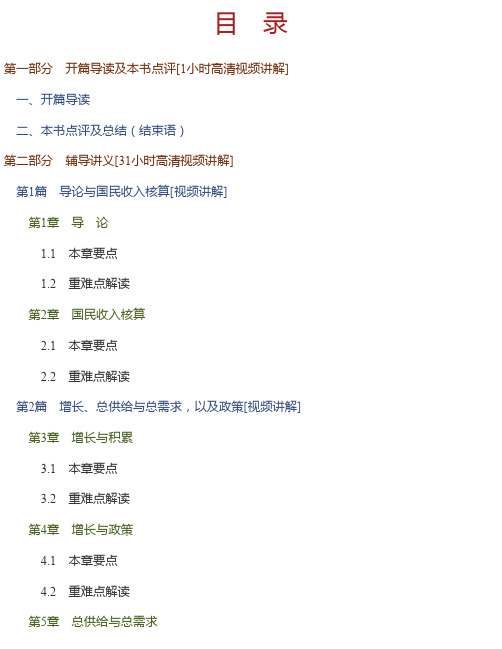
目 录第一部分 开篇导读及本书点评[1小时高清视频讲解]一、开篇导读二、本书点评及总结(结束语)第二部分 辅导讲义[31小时高清视频讲解]第1篇 导论与国民收入核算[视频讲解]第1章 导 论1.1 本章要点1.2 重难点解读第2章 国民收入核算2.1 本章要点2.2 重难点解读第2篇 增长、总供给与总需求,以及政策[视频讲解]第3章 增长与积累3.1 本章要点3.2 重难点解读第4章 增长与政策4.1 本章要点4.2 重难点解读第5章 总供给与总需求5.1 本章要点5.2 重难点解读第6章 总供给:工资、价格与失业6.1 本章要点6.2 重难点解读第7章 通货膨胀与失业的解剖7.1 本章要点7.2 重难点解读第8章 政策预览8.1 本章要点8.2 重难点解读第3篇 首要的几个模型[视频讲解]第9章 收入与支出9.1 本章要点9.2 重难点解读第10章 货币、利息与收入10.1 本章要点10.2 重难点解读第11章 货币政策与财政政策11.1 本章要点11.2 重难点解读第12章 国际联系12.1 本章要点12.2 重难点解读第4篇 行为的基础[视频讲解]第13章 消费与储蓄13.1 本章要点13.2 重难点解读第14章 投资支出14.1 本章要点14.2 重难点解读第15章 货币需求15.1 本章要点15.2 重难点解读第16章 联邦储备、货币与信用16.1 本章要点16.2 重难点解读第17章 政 策17.1 本章要点17.2 重难点解读第18章 金融市场与资产价格18.1 本章要点18.2 重难点解读第5篇 重大事件、国际调整和前沿课题[视频讲解]第19章 重大事件:萧条经济学、恶性通货膨胀和赤字19.1 本章要点19.2 重难点解读第20章 国际调整与相互依存20.1 本章要点20.2 重难点解读第21章 前沿课题21.1 本章要点21.2 重难点解读第三部分 名校考研真题名师精讲及点评[8小时高清视频讲解]一、名词解释二、简答题三、计算题四、论述题第一部分 开篇导读及本书点评[1小时高清视频讲解]一、开篇导读[0.5小时高清视频讲解]主讲老师:郑炳一、教材及教辅、课程、题库简介► 教材:多恩布什《宏观经济学》(第10版)(多恩布什、费希尔、斯塔兹著,王志伟译,中国人民大学出版社)► 教辅(两本,文库考研网主编,中国石化出版社出版)√网授精讲班【教材精讲+考研真题串讲】精讲教材章节内容,穿插经典考研真题,分析各章考点、重点和难点。
多恩布什《宏观经济学》第10版课后习题详解(增长与积累)【圣才出品】
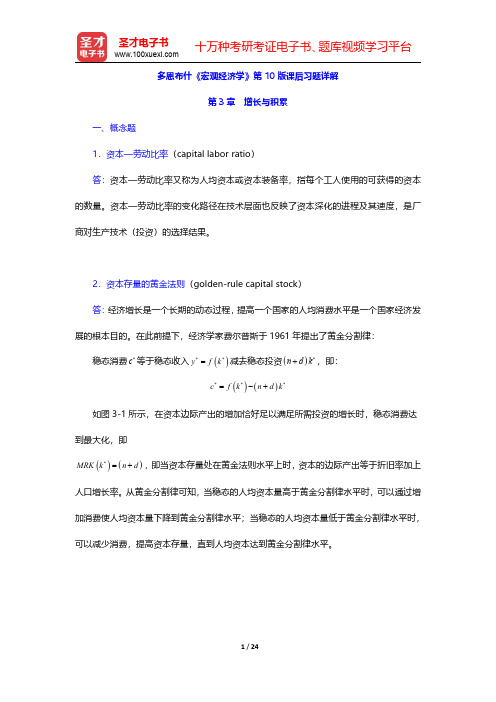
多恩布什《宏观经济学》第10版课后习题详解第3章增长与积累一、概念题1.资本—劳动比率(capital labor ratio)答:资本—劳动比率又称为人均资本或资本装备率,指每个工人使用的可获得的资本的数量。
资本—劳动比率的变化路径在技术层面也反映了资本深化的进程及其速度,是厂商对生产技术(投资)的选择结果。
2.资本存量的黄金法则(golden-rule capital stock)答:经济增长是一个长期的动态过程,提高一个国家的人均消费水平是一个国家经济发展的根本目的。
在此前提下,经济学家费尔普斯于1961年提出了黄金分割律:稳态消费c *等于稳态收入()y f k **=减去稳态投资()n d k *+,即:()()c f k n d k ***=-+如图3-1所示,在资本边际产出的增加恰好足以满足所需投资的增长时,稳态消费达到最大化,即()()MRK k n d *=+,即当资本存量处在黄金法则水平上时,资本的边际产出等于折旧率加上人口增长率。
从黄金分割律可知,当稳态的人均资本量高于黄金分割律水平时,可以通过增加消费使人均资本量下降到黄金分割律水平;当稳态的人均资本量低于黄金分割律水平时,可以减少消费,提高资本存量,直到人均资本达到黄金分割律水平。
图3-1经济增长的黄金分割律3.劳动的边际产出(marginal product of labor,MPL )答:劳动的边际产出指在其他要素投入保持不变的情况下,增加一单位劳动所获得的产品的增量。
劳动的边际产出用公式可以表示为MPL TP L =∆,当劳动的增加量非常小时,d MPL TP =。
劳动的边际产出曲线的变化趋势是倒U 形的,这就意味着当边际产出为零时总产出达到最大值。
在图形上,总产出曲线上各点切线的斜率值,就是各劳动投入量上边际产出的数值。
一个企业主在考虑再雇佣一名工人时,在劳动的平均产出和边际产出中他更关心劳动的边际产出。
4.柯布-道格拉斯生产函数(Cobb Douglas Production Function)答:柯布-道格拉斯生产函数是由美国的数学家柯布和经济学家道格拉斯提出来的生产函数。
多恩布什《宏观经济学》笔记和课后习题详解(收入与支出)【圣才出品】
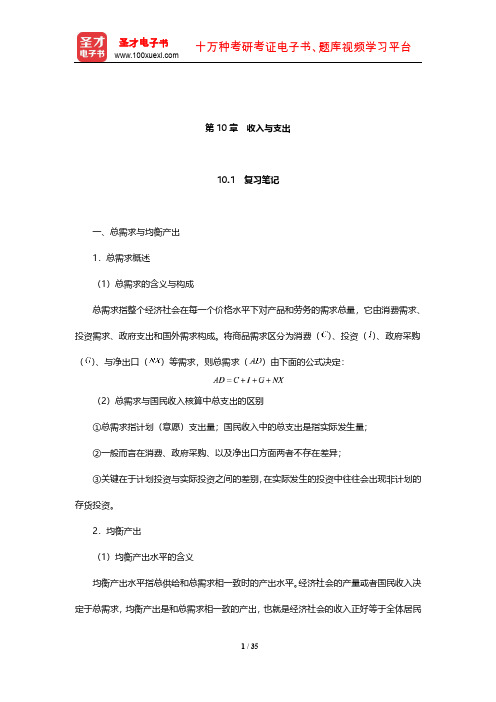
第10章收入与支出10.1 复习笔记一、总需求与均衡产出1.总需求概述(1)总需求的含义与构成总需求指整个经济社会在每一个价格水平下对产品和劳务的需求总量,它由消费需求、投资需求、政府支出和国外需求构成。
将商品需求区分为消费()、投资()、政府采购()、与净出口()等需求,则总需求()由下面的公式决定:(2)总需求与国民收入核算中总支出的区别①总需求指计划(意愿)支出量;国民收入中的总支出是指实际发生量;②一般而言在消费、政府采购、以及净出口方面两者不存在差异;③关键在于计划投资与实际投资之间的差别,在实际发生的投资中往往会出现非计划的存货投资。
2.均衡产出(1)均衡产出水平的含义均衡产出水平指总供给和总需求相一致时的产出水平。
经济社会的产量或者国民收入决定于总需求,均衡产出是和总需求相一致的产出,也就是经济社会的收入正好等于全体居民和企业想要有的产出。
当下式成立时,经济处于均衡产出水平状态:(2)非计划库存投资与产量调节机制当总需求即人们想要购买的量与产出不相等时,则存在非计划库存投资或负投资。
可将其概括为:,其中为非计划的库存投资。
①如果产出大于总需求,就有非计划库存投资,此时存在超额库存积累,企业会减少生产,直到产出与总需求再度均衡为止。
②如果产出低于总需求,,企业将增加生产直至均衡恢复为止。
③在均衡状态下,非计划存货投资为零,,企业没有增加或减少产出的激励。
以上论述的以存货调整为基础的产量调节机制如图10-1所示。
图10-1 产出调节机制3.基本结论(1)总需求决定均衡产出(收入)水平(2)在均衡时,非计划库存投资等于零,而且消费者、政府以及外国居民都买到了他们想要购买的商品。
(3)以非计划库存变化为基础的产量调整将使经济达到均衡水平。
二、消费函数与总需求1.消费函数(1)假定条件①不考虑政府部门和对外贸易的影响,即与;②消费需求随收入水平的提高而增加。
(2)消费函数消费函数是描述消费与诸种影响因素之间的数学关系的函数。
多恩布什《宏观经济学》(第10版)笔记和课后习题详解 第14章 投资支出【圣才出品】

第14章投资支出14.1复习笔记一、对资本的存量的需求和投资流量1.关于投资的几个基本概念(1)投资①投资的一般含义投资一般指经济主体为获取预期收益而垫付货币或其他资源于某些事业的经济活动。
按投资对象,可分为以下几种投资类型:a.实物投资,即对固定资产和存货等资本品的投资。
实物投资按是否增加资本品的存量,可分为净投资和重置投资。
净投资指在一定时期内增加资本品存量的实物投资。
重置投资指并不增加资本品的存量,而只是对资本品的损耗进行补偿的实物投资。
净投资和重置投资之和称为“总投资”。
b.金融投资,即对金融资产的购买,如购买债券、股票等。
c.人力资本投资,即:使人力资本形成和增值的投资活动。
②企业会计核算中投资的含义在企业财务会计中,投资指企业为通过分配来增加财富或为谋求其他利益,将资产让渡给其他单位而获得的另一项资产。
在企业财务会计中投资分为短期投资和长期投资。
在企业现金流量表中,投资指企业长期资产的购建和不包括在现金等价物范围内的投资及其处置活动。
③投资支出的三个特点a.投资支出变动非常剧烈,造成了贯穿整个经济周期过程的GDP的绝大部分波动。
b.投资支出是一个基本环节,通过它,利率、货币政策才会影响到经济。
影响投资的税收政策是财政政策的重要工具。
c.在供给方面,投资在长时期里决定资本存量的规模,并因而有助于决定长期经济增长。
(2)投资流量投资流量,即在宏观经济学中投资具有的狭窄和技术性的含义,指投资是用来增加物质资本存货的支出流量。
投资的流量和投资的存量相比是相当小的。
投资流量与资本存量相比也是很小的,但是经过长时期以后,投资流量就完全决定了资本存量的高度,并且因而成为总供给的最重要的决定因素之一。
(3)资本存量资本存量指资本是一种存量,是给定了的所有建筑物、机器的货币(美元)价值和某一时点上的存货。
投资是由企业在一个给定的时期内加到资本存量上去的支出数量,是一个流量概念。
资本存量的变化可能有两个原因:①投资增加了资本存量;②原有资本磨损,即折旧,减少了资本存量。
多恩布什《宏观经济学》配套题库【课后习题-导论与国民收入核算】【圣才出品】

第1篇导论与国民收入核算第1章导论一、概念题1.总需求曲线(aggregate demand curve)答:总需求曲线表示产品市场和货币市场同时达到均衡时价格水平与国民收入间的依存关系的曲线。
总需求指整个经济社会在每一个价格水平下对产品和劳务的需求总量,它由消费需求、投资需求、政府支出和国外需求构成。
在其他条件不变的情况下,当价格水平提高时,国民收入水平就下降;当价格水平下降时,国民收入水平就上升。
总需求曲线向下倾斜,其机制在于:当价格水平上升时,将会同时打破产品市场和货币市场上的均衡。
在货币市场上,价格水平上升导致实际货币供给下降,从而使LM曲线向左移动,均衡利率水平上升,国民收入水平下降。
在产品市场上,一方面由于利率水平上升造成投资需求下降(即利率效应),总需求随之下降;另一方面,价格水平的上升还导致人们的财富和实际收入水平下降以及本国出口产品相对价格的提高从而使人们的消费需求下降,本国的出口也会减少,国外需求减少,进口增加。
这样,随着价格水平的上升,总需求水平就会下降。
总需求曲线的斜率反映价格水平变动一定幅度使国民收入(或均衡支出水平)变动多少。
IS曲线斜率不变时,LM曲线越陡,则LM移动时收入变动就越大,从而AD曲线越平缓;相反,LM曲线斜率不变时,IS曲线越平缓(即投资需求对利率变动越敏感或边际消费倾向越大),则LM曲线移动时收入变动越大,从而AD曲线也越平缓。
政府采取扩张性财政政策(如扩大政府支出)或扩张性货币政策都会使总需求曲线向右上方移动;反之,则向左下方移动。
2.总供给一总需求模型(aggregate supply-aggregate demand model )答:总供给—总需求模型是把总需求与总供给结合在一起来分析国民收入与价格水平的决定及其变动的国民收入决定模型。
在图1-1中,横轴代表国民收入(Y ),纵轴代表价格水平(P ),1AD 代表原来的总需求曲线,1AS 代表短期总供给曲线,2AS 代表长期总供给曲线。
多恩布什《宏观经济学》第10版课后习题详解(货币需求)【圣才出品】
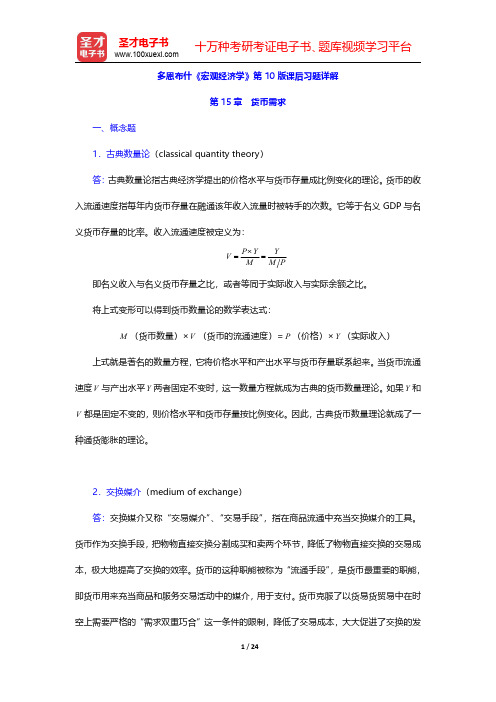
多恩布什《宏观经济学》第10版课后习题详解第15章货币需求一、概念题1.古典数量论(classical quantity theory)答:古典数量论指古典经济学提出的价格水平与货币存量成比例变化的理论。
货币的收入流通速度指每年内货币存量在融通该年收入流量时被转手的次数。
它等于名义GDP 与名义货币存量的比率。
收入流通速度被定义为:P Y Y V M M P ⨯==即名义收入与名义货币存量之比,或者等同于实际收入与实际余额之比。
将上式变形可以得到货币数量论的数学表达式:M (货币数量)×V (货币的流通速度)=P (价格)×Y (实际收入)上式就是著名的数量方程,它将价格水平和产出水平与货币存量联系起来。
当货币流通速度V 与产出水平Y 两者固定不变时,这一数量方程就成为古典的货币数量理论。
如果Y 和V 都是固定不变的,则价格水平和货币存量按比例变化。
因此,古典货币数量理论就成了一种通货膨胀的理论。
2.交换媒介(medium of exchange)答:交换媒介又称“交易媒介”、“交易手段”,指在商品流通中充当交换媒介的工具。
货币作为交换手段,把物物直接交换分割成买和卖两个环节,降低了物物直接交换的交易成本,极大地提高了交换的效率。
货币的这种职能被称为“流通手段”,是货币最重要的职能,即货币用来充当商品和服务交易活动中的媒介,用于支付。
货币克服了以货易货贸易中在时空上需要严格的“需求双重巧合”这一条件的限制,降低了交易成本,大大促进了交换的发展。
3.货币数量论(quantity theory of money)答:货币数量论是关于名义总收入只决定于货币数量变动的理论,是一种历史悠久的货币理论。
货币数量论以费雪交易方程式为依据,即MV PY(其中P为价格,Y为实际产出,故PY为名义总收入,M货币数量,V为货币流通速度)。
这种理论最早由16世纪法国经济学家波丹提出,现在继承这一传统的是美国经济学家弗里德曼的现代货币数量论。
(完整版)多恩布什宏观经济学第十版课后答案
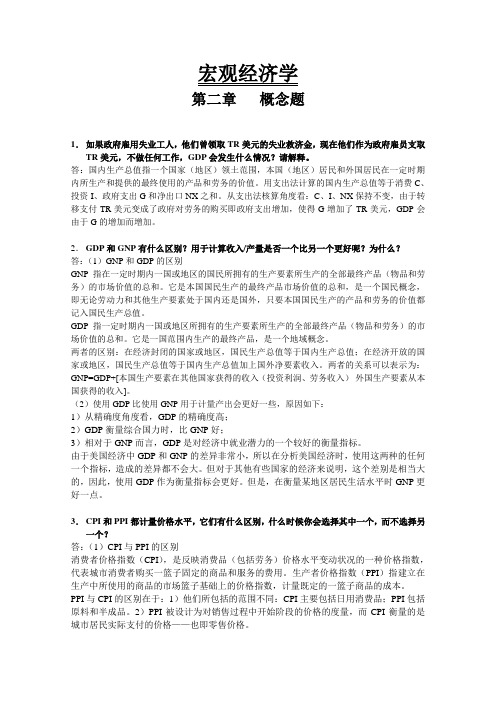
宏观经济学第二章概念题1.如果政府雇用失业工人,他们曾领取TR美元的失业救济金,现在他们作为政府雇员支取TR美元,不做任何工作,GDP会发生什么情况?请解释。
答:国内生产总值指一个国家(地区)领土范围,本国(地区)居民和外国居民在一定时期内所生产和提供的最终使用的产品和劳务的价值。
用支出法计算的国内生产总值等于消费C、投资I、政府支出G和净出口NX之和。
从支出法核算角度看:C、I、NX保持不变,由于转移支付TR美元变成了政府对劳务的购买即政府支出增加,使得G增加了TR美元,GDP会由于G的增加而增加。
2.GDP和GNP有什么区别?用于计算收入/产量是否一个比另一个更好呢?为什么?答:(1)GNP和GDP的区别GNP指在一定时期内一国或地区的国民所拥有的生产要素所生产的全部最终产品(物品和劳务)的市场价值的总和。
它是本国国民生产的最终产品市场价值的总和,是一个国民概念,即无论劳动力和其他生产要素处于国内还是国外,只要本国国民生产的产品和劳务的价值都记入国民生产总值。
GDP指一定时期内一国或地区所拥有的生产要素所生产的全部最终产品(物品和劳务)的市场价值的总和。
它是一国范围内生产的最终产品,是一个地域概念。
两者的区别:在经济封闭的国家或地区,国民生产总值等于国内生产总值;在经济开放的国家或地区,国民生产总值等于国内生产总值加上国外净要素收入。
两者的关系可以表示为:GNP=GDP+[本国生产要素在其他国家获得的收入(投资利润、劳务收入)-外国生产要素从本国获得的收入]。
(2)使用GDP比使用GNP用于计量产出会更好一些,原因如下:1)从精确度角度看,GDP的精确度高;2)GDP衡量综合国力时,比GNP好;3)相对于GNP而言,GDP是对经济中就业潜力的一个较好的衡量指标。
由于美国经济中GDP和GNP的差异非常小,所以在分析美国经济时,使用这两种的任何一个指标,造成的差异都不会大。
但对于其他有些国家的经济来说明,这个差别是相当大的,因此,使用GDP作为衡量指标会更好。
多恩布什《宏观经济学》第10版课后习题详解(国民收入核算)【圣才出品】

多恩布什《宏观经济学》第10版课后习题详解第2章国民收入核算一、概念题1.校正的GNP(adjusted GNP)答:校正的GNP指以具有不变购买力的货币单位衡量的国民生产总值。
为了消除价格变动对国民生产总值的影响,一般是以某一年为基期,以该年的价格为不变价格,然后用物价指数来矫正名义国民生产总值,计算出实际国民生产总值。
由于通货膨胀或通货紧缩会提高或降低物价水平,因而会使货币的购买力随物价的波动而发生变化。
实际国民生产总值能准确地反映产量的变动情况。
一般来说,在通货膨胀的情况下,实际国民生产总值小于按当年价格计算的国民生产总值;在通货紧缩的情况下,实际国民生产总值大于按当年价格计算的国民生产总值。
2.政府采购(government purchases)答:政府采购亦称“公共采购”,指市场经济国家为加强对政府公共支出的管理,规定各级政府及所属机构在购买执行其职能所需的货物、工程或服务时,必须以公开竞争性招标采购的方式进行购买。
政府采购是采购政策、采购程序、采购过程和采购管理的总称。
政府采购主要有以下特点:①政府采购主体是依靠国家预算资金运作的政府机关、事业单位、社会团体等;②政府采购是非商业性、非盈利性的购买行为;③政府采购以公开竞争招标的方式进行;④政府采购方式多样,范围广泛。
政府采购有利于加强对公共支出资金的管理。
竞争招标方式使政府能在购买到较好的产品服务的前提下,尽可能节约资金,也可以避免采购中的腐败行为。
3.净出口(net exports)答:净出口指出口与进口的差额。
用X表示出口,用M表示进口,则(X M-)就是净出口。
进口应从本国总购买中减去,因为进口表示收入流到国外,同时也不是用于购买本国产品的支出;出口则应加进本国总购买量之中,因为出口表示收入从外国流入,是用于购买本国产品的支出。
因此,净出口应计入总支出,它可能是正值,也可能是负值。
4.权重连锁指数(chain-weighted index)答:权重连锁指数是指鉴于一种商品的价格提高快于另一种商品价格的提高时,消费者会将其消费从现在相对昂贵的商品转移到相对不太昂贵的商品上,通过校正商品篮子变化计算的指数。
多恩布什《宏观经济学》配套题库【课后习题-投资支出】【圣才出品】
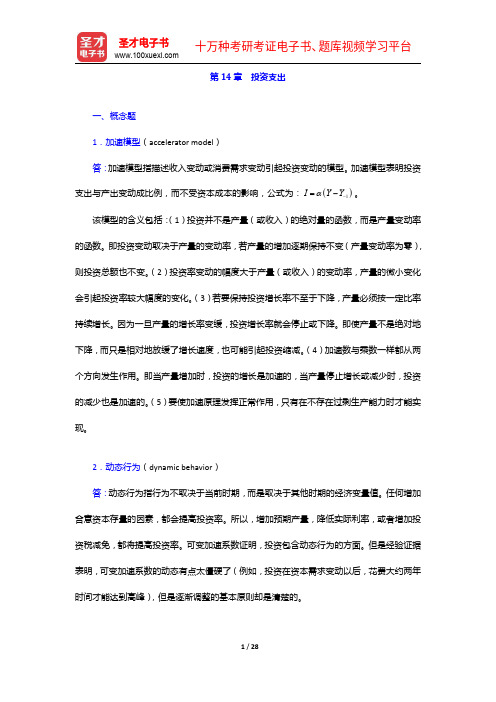
第14章投资支出一、概念题1.加速模型(accelerator model )答:加速模型指描述收入变动或消费需求变动引起投资变动的模型。
加速模型表明投资支出与产出变动成比例,而不受资本成本的影响,公式为:()1I Y Y α-=-。
该模型的含义包括:(1)投资并不是产量(或收入)的绝对量的函数,而是产量变动率的函数。
即投资变动取决于产量的变动率,若产量的增加逐期保持不变(产量变动率为零),则投资总额也不变。
(2)投资率变动的幅度大于产量(或收入)的变动率,产量的微小变化会引起投资率较大幅度的变化。
(3)若要保持投资增长率不至于下降,产量必须按一定比率持续增长。
因为一旦产量的增长率变缓,投资增长率就会停止或下降。
即使产量不是绝对地下降,而只是相对地放缓了增长速度,也可能引起投资缩减。
(4)加速数与乘数一样都从两个方向发生作用。
即当产量增加时,投资的增长是加速的,当产量停止增长或减少时,投资的减少也是加速的。
(5)要使加速原理发挥正常作用,只有在不存在过剩生产能力时才能实现。
2.动态行为(dynamic behavior )答:动态行为指行为不取决于当前时期,而是取决于其他时期的经济变量值。
任何增加合意资本存量的因素,都会提高投资率。
所以,增加预期产量,降低实际利率,或者增加投资税减免,都将提高投资率。
可变加速系数证明,投资包含动态行为的方面。
但是经验证据表明,可变加速系数的动态有点太僵硬了(例如,投资在资本需求变动以后,花费大约两年时间才能达到高峰),但是逐渐调整的基本原则却是清楚的。
3.适时存货管理(just in time inventory management)答:适时存货管理指企业一生产出产品就立即将其卖掉,并且订购的只是它们最需要的部分,企业尽可能缩短持有存货时间的这样一种存货管理策略。
如果存货与销售量或总需求能够更紧密地保持一致,存货投资与GDP两者的波动将会减少。
由于企业的经营方法一直在改进,经常希望新的管理方法能使企业对其存货保持严格的控制,因而更为稳定的增长前景得以改善。
- 1、下载文档前请自行甄别文档内容的完整性,平台不提供额外的编辑、内容补充、找答案等附加服务。
- 2、"仅部分预览"的文档,不可在线预览部分如存在完整性等问题,可反馈申请退款(可完整预览的文档不适用该条件!)。
- 3、如文档侵犯您的权益,请联系客服反馈,我们会尽快为您处理(人工客服工作时间:9:00-18:30)。
圣才电子书 十万种考研考证电子书、题库视频学习平台
说成是可支配收入储蓄倾向。
7.平衡预算乘数(balanced budget multiplier)
答:平衡预算乘数指在税收和政府购买等量增加的时候所引起的产出增加的倍数,是政
府收入和支出同时以相等数量增加或减小时国民收入变动对政府支出变动的比率。
5.可支配收入(disposable income) 答:可支配收入是反映居民家庭全部现金收入中能用于安排家庭日常生活的那部分收 入,即用家庭中得到的全部现金收入减去个人所得税、减去记账补贴及家庭从事副业生产支 出的费用。可支配收入一般指个人可支配收入,后者是一个国家所有个人(包括私人非营利 性机构)在一定时期(通常为一年)内实际得到的可用于个人消费或储蓄的那一部分收入。 个人收入不能全归个人支配,因为还要缴纳个人所得税,因此,税后的个人收入才是个人可 支配收入,即人们可随意用来消费和储蓄的收入。个人可支配收入等于个人收入扣除向政府 缴纳的所得税、遗产税和赠予税、不动产税、人头税、汽车使用税以及交给政府的非商业性 费用等以后的余额。个人可支配收入被认为是消费开支的最重要的决定性因素,常被用来衡 量一国的生活水平。
假设政府购买和税收各增加同一数量,即 G T 时:
Y
k g G
kT T
1
b
1
1
t
G
b 1 t 1 b 1 t
T
1b11t NhomakorabeaG
b 1 t 1 b 1 t
G
G
kB
Y G
1
无论在定量税还是比例税下,平衡预算乘数均为 1。根据平衡预算乘数,可以把财政政
圣才电子书 十万种考研考证电子书、题库视频学习平台
多恩布什《宏观经济学》第 10 版课后习题详解 第 9 章 收入与支出
一、概念题 1.总需求(aggregate demand) 答:总需求指整个经济社会在每一个价格水平下对产品和劳务的需求总量,它由消费需 求、投资需求、政府购买支出和国外需求构成。总需求函数表示产品市场和货币市场同时达 到均衡时的价格水平与国民收入间的依存关系,描述这一函数的曲线称为总需求曲线。 总需求曲线向下倾斜,其机制在于:当价格水平上升时,将会同时打破产品市场和货币 市场的均衡。在货币市场上,价格水平上升导致实际货币供给下降,从而使 LM 曲线向左移 动,均衡利率水平上升,国民收入水平下降。在产品市场上,一方面由于利率水平上升造成 投资需求下降(即利率效应),总需求随之下降;另一方面,价格水平的上升还导致人们的 财富减少和实际收入水平下降,以及本国出口产品相对价格的提高,从而使人们的消费需求 下降,本国的出口也会减少、国外需求减少,进口增加。这样,随着价格水平的上升,总需 求水平就会下降。
1 / 18
圣才电子书 十万种考研考证电子书、题库视频学习平台
C C0 cY , C0 0 , c 1 ,其中 c 即是边际消费倾向( MPC ), C0 为自主消费。 依据收入—消费关系分析时间的长短,消费函数又分为短期消费函数和长期消费函数。
3.边际消费倾向(marginal propensity of consume)
答:边际消费倾向指可支配收入每增加一美元时消费的增量,可以用以下公式表示:
MPC
C Y
C 表示增加的消费, Y 代表增加的收入。一般而言,边际消费倾向在 0 和 1 之间波
动。在西方经济学中,任何增加的收入无非两个用途:消费和储蓄。所以,边际消费倾向与
边际储蓄倾向之和必定为 1(即
MPC MPS 1 )。边际消费倾向是递减的,当人们收入增加时,消费也会随之增加,但增
2.消费函数(consumption function) 答:消费函数是描述消费与诸种影响因素之间的数学关系的函数。宏观经济中,消费支 出受多种因素影响,如国民收入水平、物价水平、利率、收入分配、个人偏好和社会习俗等 等。 经济学家一般认为,在影响消费的各种因素中,收入是影响消费最重要、最稳定的因素, 即消费是收入的函数,根据凯恩斯的收入决定理论,收入是消费的主要决定因素,利率并不 重要,因而消费函数的表达式为
6.边际储蓄倾向(marginal propensity of save) 答:边际储蓄倾向指可支配收入每增加一单位时储蓄的增量。即可支配收入增加一单位 所引起的储蓄的变化,它等于 1 减去边际消费倾向( MPS 1 MPC ),可以表示为: MPS S Y 。 其中 Y 表示收入的变化量,S 表示储蓄的变化量。一般而言,边际储蓄倾向在 0 和 1 之间波动。因为全部新增收入要么用来消费,要么用来储蓄,所以边际储蓄倾向与边际消费 倾向之和为 1(即 MPC MPS 1 )。边际消费倾向可以说成是国民收入的储蓄倾向,也可以
加的幅度却不断下降。即随着收入的上升,在增加的每单位收入中,消费所占的比重越来越
小,储蓄所占的比重却越来越大。
4.自动稳定器(automatic stabilizer) 答:自动稳定器又称“内在稳定器(built-in stabilizer)”,指在国民经济中无需经常变 动政府政策而有助于经济自动趋向稳定的因素。例如,一些财政支出和税收制度就具有某种 自动调整经济的灵活性,可以自动配合需求管理,减缓总需求的摇摆性,从而有助于经济的 稳定。 在社会经济生活中,通常具有内在稳定器作用的因素主要包括:个人和公司所得税、失 业补助和其他福利转移支付、农产品维持价格以及公司储蓄和家庭储蓄等等。例如,在萧条 时期,个人收入和公司利润减少,政府所得税收入自动减少,从而相应增加了消费和投资。 同时,随着失业人数的增加,政府失业救济金和各种福利支出必然要增加,又将刺激个人消
2 / 18
圣才电子书 十万种考研考证电子书、题库视频学习平台
费和促进投资。但是,内在稳定器的作用是有限的,它只能配合需求管理来稳定经济,而本 身不足以完全维持经济的稳定;它只能缓和或减轻经济衰退或通货膨胀的程度,而不能改变 它们的总趋势。因此,还必须采用更有力的财政政策措施。
